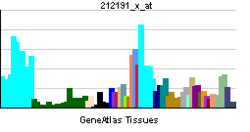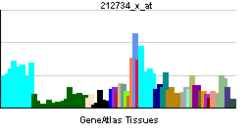60S ribosomal protein L13
60S ribosomal protein L13' is a protein that in humans is encoded by the RPL13 gene.[3][4]
Function
Ribosomes, the organelles that catalyze protein synthesis, consist of a small 40S subunit and a large 60S subunit. Together these subunits are composed of 4 RNA species and approximately 80 structurally distinct proteins. This gene encodes a ribosomal protein that is a component of the 60S subunit. The protein belongs to the L13E family of ribosomal proteins. It is located in the cytoplasm. This gene is expressed at significantly higher levels in benign breast lesions than in breast carcinomas. Transcript variants derived from alternative splicing and/or alternative polyadenylation exist; these variants encode the same protein. As is typical for genes encoding ribosomal proteins, there are multiple processed pseudogenes of this gene dispersed through the genome.[4]
Interactions
RPL13 has been shown to interact with CDC5L.[5]
References
- ↑ "Human PubMed Reference:".
- ↑ "Mouse PubMed Reference:".
- ↑ Kenmochi N, Kawaguchi T, Rozen S, Davis E, Goodman N, Hudson TJ, Tanaka T, Page DC (August 1998). "A map of 75 human ribosomal protein genes". Genome Res. 8 (5): 509–23. doi:10.1101/gr.8.5.509. PMID 9582194.
- 1 2 "Entrez Gene: RPL13 ribosomal protein L13".
- ↑ Ajuh P, Kuster B, Panov K, Zomerdijk JC, Mann M, Lamond AI (December 2000). "Functional analysis of the human CDC5L complex and identification of its components by mass spectrometry". EMBO J. 19 (23): 6569–81. doi:10.1093/emboj/19.23.6569. PMC 305846
 . PMID 11101529.
. PMID 11101529.
Further reading
- Wool IG, Chan YL, Glück A (1996). "Structure and evolution of mammalian ribosomal proteins.". Biochem. Cell Biol. 73 (11–12): 933–47. doi:10.1139/o95-101. PMID 8722009.
- Adams SM, Helps NR, Sharp MG, Brammar WJ, Walker RA, Varley JM (1993). "Isolation and characterization of a novel gene with differential expression in benign and malignant human breast tumours". Hum. Mol. Genet. 1 (2): 91–6. doi:10.1093/hmg/1.2.91. PMID 1301162.
- Kato S, Sekine S, Oh SW, Kim NS, Umezawa Y, Abe N, Yokoyama-Kobayashi M, Aoki T (1995). "Construction of a human full-length cDNA bank". Gene. 150 (2): 243–50. doi:10.1016/0378-1119(94)90433-2. PMID 7821789.
- Yaseen NR, Blobel G (1997). "Cloning and characterization of human karyopherin beta3". Proc. Natl. Acad. Sci. U.S.A. 94 (9): 4451–6. doi:10.1073/pnas.94.9.4451. PMC 20743
 . PMID 9114010.
. PMID 9114010.
- Andersen JS, Lyon CE, Fox AH, Leung AK, Lam YW, Steen H, Mann M, Lamond AI (2002). "Directed proteomic analysis of the human nucleolus". Curr. Biol. 12 (1): 1–11. doi:10.1016/S0960-9822(01)00650-9. PMID 11790298.
- Bi W, Yan J, Stankiewicz P, Park SS, Walz K, Boerkoel CF, Potocki L, Shaffer LG, Devriendt K, Nowaczyk MJ, Inoue K, Lupski JR (2002). "Genes in a refined Smith-Magenis syndrome critical deletion interval on chromosome 17p11.2 and the syntenic region of the mouse". Genome Res. 12 (5): 713–28. doi:10.1101/gr.73702. PMC 186594
 . PMID 11997338.
. PMID 11997338.
- Andersen JS, Lam YW, Leung AK, Ong SE, Lyon CE, Lamond AI, Mann M (2005). "Nucleolar proteome dynamics". Nature. 433 (7021): 77–83. doi:10.1038/nature03207. PMID 15635413.
- Kobayashi T, Sasaki Y, Oshima Y, Yamamoto H, Mita H, Suzuki H, Toyota M, Tokino T, Itoh F, Imai K, Shinomura Y (2006). "Activation of the ribosomal protein L13 gene in human gastrointestinal cancer". Int. J. Mol. Med. 18 (1): 161–70. doi:10.3892/ijmm.18.1.161. PMID 16786168.



 . PMID 11101529.
. PMID 11101529. . PMID 9114010.
. PMID 9114010. . PMID 11997338.
. PMID 11997338.